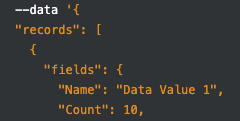Hello,
I’m wanting to know if it is possible to add a row when things are added to google sheets. I’ve tried using Zapier, but it doesn’t seem to work the way I want it to.
It is not letting me add a picture of it to this post, so here is a link to it: imgur[dot]com/XadQ88y
I want to be able to put businesses names in each of the Business 1, 2, 3… sections and their email in the corresponding spot.
When I use Zapier, if I put business 1 and business 2 in at the same time, they end up in the same cell in Airtable. I want them to get their own row.
Is there a way for me to do that?



